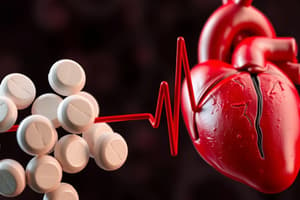Podcast
Questions and Answers
Which part of the heart experiences a reduced speed of conduction at the atrioventricular (AV) node?
Which part of the heart experiences a reduced speed of conduction at the atrioventricular (AV) node?
- SA node
- Bundle of His
- Atria (correct)
- Ventricles
What is the purpose of antiarrhythmic drugs in the context of cardiac rhythm?
What is the purpose of antiarrhythmic drugs in the context of cardiac rhythm?
- Alter the duration of the effective refractory period (correct)
- Promote abnormal automaticity
- Decrease excitability of cardiac cells
- Increase conduction velocity
Where do the impulses travel after passing through the Bundle of His in a normal cardiac rhythm?
Where do the impulses travel after passing through the Bundle of His in a normal cardiac rhythm?
- Ventricles
- SA node
- Atria
- Purkinje fibers (correct)
Which term best describes very rapid but regular contractions of the heart?
Which term best describes very rapid but regular contractions of the heart?
Which classification of arrythmias involves unsynchronized and irregular contractile activity?
Which classification of arrythmias involves unsynchronized and irregular contractile activity?
What is the primary role of Class 2 antiarrhythmic drugs in managing arrhythmias?
What is the primary role of Class 2 antiarrhythmic drugs in managing arrhythmias?
What is the main goal of using antiarrhythmic drug therapy in animals?
What is the main goal of using antiarrhythmic drug therapy in animals?
Which class of antiarrhythmics primarily target potassium channels?
Which class of antiarrhythmics primarily target potassium channels?
In which type of arrhythmia are the electrical impulses of the heart changed leading to erratic heartbeats?
In which type of arrhythmia are the electrical impulses of the heart changed leading to erratic heartbeats?
Which class of antiarrhythmics act by blocking sodium channels?
Which class of antiarrhythmics act by blocking sodium channels?
What is the significance of arrhythmias associated with a cardiac disease?
What is the significance of arrhythmias associated with a cardiac disease?
What term refers to the automatic or spontaneous depolarization of pace maker cells at Phase 4 of action potential?
What term refers to the automatic or spontaneous depolarization of pace maker cells at Phase 4 of action potential?
In hyperkalemia, which ion has a high concentration outside rather than inside, leading to bradycardia?
In hyperkalemia, which ion has a high concentration outside rather than inside, leading to bradycardia?
Which type of antiarrhythmics are primarily responsible for reducing the automaticity of pacemaker cells in the heart?
Which type of antiarrhythmics are primarily responsible for reducing the automaticity of pacemaker cells in the heart?
What effect does hypokalemia have on K+ concentration, resulting in changes in heart rhythm?
What effect does hypokalemia have on K+ concentration, resulting in changes in heart rhythm?
Which condition causes the slope of phase 4 to be decreased, leading to bradycardia due to the deterrence of K+ outflow?
Which condition causes the slope of phase 4 to be decreased, leading to bradycardia due to the deterrence of K+ outflow?
Which antiarrhythmic class is commonly associated with blocking sodium channels in the heart?
Which antiarrhythmic class is commonly associated with blocking sodium channels in the heart?
Study Notes
Ventricular Arrhythmias
- Premature ventricular contraction, ventricular tachycardia, and ventricular fibrillation are types of ventricular arrhythmias.
Causes of Arrhythmias
- Abnormal impulse generation or altered automaticity can cause arrhythmias.
- Automaticity is enhanced when the slope of phase 4 is increased, decreasing the time required to reach threshold and increasing the frequency of spontaneous discharge.
- Changes in autonomic nerve activity (sympathetic and vagal) can cause arrhythmias.
- Serum ion concentrations (electrolyte imbalance) can also cause arrhythmias, such as:
- Hyperkalemia: high K+ concentration outside the cell, leading to bradycardia.
- Hypokalemia: low K+ concentration outside the cell, leading to antiarrhythmic drug use.
Antiarrhythmic Drugs
- Antiarrhythmic drugs are used to:
- Decrease or increase conduction velocity.
- Alter the excitability of cardiac cells by changing the duration of the effective refractory period.
- Suppress abnormal automaticity.
Requirements for a Normal Cardiac Rhythm
- Impulses generated by the SA node travel through the atria and converge at the atrioventricular (AV) node.
- Impulses from the AV node travel into the ventricles via the Bundle of His, and then branch into the left and right bundle branches, the terminal Purkinje fibers, and finally are conducted to the ventricular myocytes.
Classification of Arrhythmias
- Arrhythmias can be classified based on the sites where they are observed and their characteristics:
- Sites of origin: ventricular, atrial, sinus, AV node, supraventricular (atrial myocardium or AV node).
- Characteristics: flutter (very rapid but regular contractions), tachycardia (increased rate), bradycardia (decreased rate), fibrillation (disorganized, irregular, unsynchronized contractile activity).
Examples of Arrhythmias
- Supraventricular arrhythmias: paroxysmal atrial tachycardia, atrial flutter, atrial fibrillation.
Therapeutic Goal of Antiarrhythmic Drugs
- The main goal of using antiarrhythmic drug therapy is to restore normal rhythm and conduction of the heart in animals having abnormalities in heart rhythm and conduction.
Studying That Suits You
Use AI to generate personalized quizzes and flashcards to suit your learning preferences.
Description
Test your knowledge on antiarrhythmic drugs and normal cardiac rhythm. Questions cover the effects of these drugs, the SA node, atrioventricular (AV) node, and requirements for a normal cardiac rhythm.




